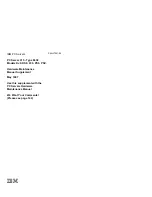
122
Appendix B: RAID Basics
Appendix B: RAID Basics
Overview
•
A Redundant Array of Independent Disks (RAID) is an array of several hard disks that provide data
security and high performance. A RAID system accesses several hard disks simultaneously, which
improves I/O performance over a single hard disk. Data security is enhanced by a RAID, since data
loss due to a hard disk failure is minimized by regenerating redundant data from the other RAID hard
disks.
Benefits
•
RAID improves I/O performance, and increases data security through fault tolerance and redundant
data storage.
Improved Performance
•
RAID provides access to several hard disk drives simultaneously, which greatly increases I/O
performance.
Data Security
•
Hard disk drive failure unfortunately is a common occurrence. A RAID helps prevent against the loss
of data due to hard disk failure. A RAID offers additional hard disk drives that can avert data loss from
a hard disk drive failure. If a hard drive fails, the RAID volume can regenerate data from the data and
parity stored on its other hard disk drives.
RAID Levels
•
The Thecus IP storage supports standard RAID levels 0, 1, 5, 6, 10 and JBOD. You choose a RAID level
when you create a system volume. The factors for selecting a RAID level are:
Your requirements for performance
Your need for data security
Number of hard disk drives in the system, capacity of hard disk drives in the system
The following is a description of each RAID level:
RAID 0
RAID 0 is best suited for applications that need high bandwidth but do not require a high level of
data security. The RAID 0 level provides the best performance of all the RAID levels, but it does not
provide data redundancy.
RAID 0 uses disk striping and breaking up data into blocks to write across all hard drives in the vol-
ume. The system can then use multiple hard drives for faster read and write. The stripe size parame-
ter that was set when the RAID was created determines the size of each block. No parity calculations
complicate the write operation.
RAID 1
RAID 1 mirrors all data from one hard disk drive to a second one hard disk drive, thus providing com-
plete data redundancy. However, the cost of data storage capacity is doubled.
This is excellent for complete data security.
RAID 5
RAID 5 offers data security and it is best suited for networks that perform many small I/O transactions
at the same time, as well as applications that require data security such as office automation and on-










































